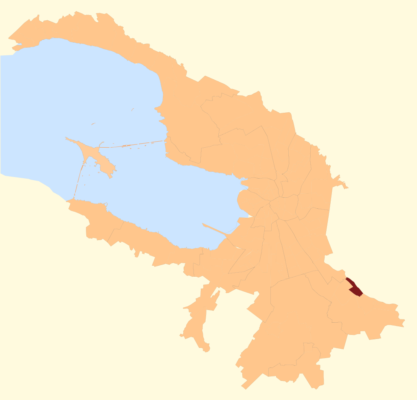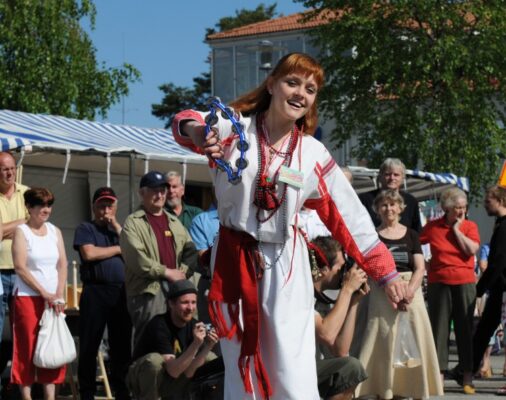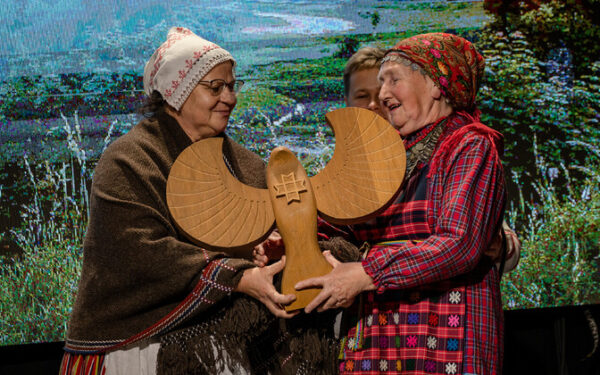
Izhorians
Names
Izhorians refer to themselves as inkeroine or izhora, karjalain and more generally maaväki. The word “Izhorian” may originate from the Russian-language name of the Neva river tributary izhora, to which the corresponding Baltic-Finnic name is inkeri. In Finland, Izhorians are usually considered as Orthodox Ingrian Finns, while in Russia and the Soviet Union Izhorians and Ingrian Finns were always distinguished from each other. In English, the Izhorian language is also called Ingrian, which can, however, cause confusion with the Ingrian Finns.


Territory
Together with Votians, Izhorians are the indigenous people of Ingria. Ingria is an area covering 15 000 km2 between the Narva river and Lake Ladoga. Izhorians live in a few villages in the northern and northwestern parts of Ingria at the downstream of the Luga river, on Kurgola and Soikkola peninsulas and in the Hevaha (Kovash) river system. Administratively these territories belong to the Kingissep and Lomonossov districts of the Leningrad Oblast.
Population
According to Russia’s 2010 census, the population of Izhorians was 266 – a 13% decline compared to 2002 (327 persons). Moreover, the number of Izhorian speakers declined 66% (from 362 speakers in 2002 to just 123 speakers in 2010).
As of 2002, 177 Izhorians lived in Leningrad Oblast and 53 in St. Petersburg. 53.1% of the Izhorians of Leningrad Oblast and St. Petersburg spoke Izhorian as a mother tongue. In 1989 there were 449 Izhorians in Russia, of whom 41.9% considered Izhorian their mother tongue.
Language
Izhorian language belongs with Finnish, Karelian and Vepsian languages to the Baltic-Finnic languages, with Livvi Karelian and Eastern dialects of Finnish as its closest languages. Izhorian language, Northern Karelian and Eastern dialects of the Finnish language originate from the same proto-language which has been called Ancient Karelian language.
Izhorian language includes four main dialects: Soikkola, Hevaha (Heva), Lower Luga and Oredezhi dialects. The first is spoken mostly on Soikkola peninsula, the second in the Hevaha river system, the third on the Luga downstream and on Kurgola peninsula. The fourth (now effectively extinct) dialect was spoken in the southern part of Leningrad Oblast, in some villages of the Oredezh river system (Novinka, Tshashtsha).
Between 1932 and 1937 a Latin alphabet based written Izhorian language existed and was taught in schools. In 1936, Izhorian grammar and a few dozen textbooks were published. First Izhorian books were written on the basis of the Soikkola dialect.
History
Izhorians’ ancestors separated from Karelians probably at the beginning of the 2nd millennium A.D., migrating from the Karelian Isthmus (or from the Izhora river basin) to the west and southwest, to Votians’ territory that was later called Ingria.
Ingria belonged then to the Kievan Rus’ and since the 12th century to the feudal Novgorod Republic. Izhorian tribal leaders acted as vassals of Novgorod and over time were Russified. The territory of Izhorians and Votians was often a battleground between Novgorod and its Catholic western neighbours (Old Livonia, Sweden).
In 1478 the entire Novgorod Republic was united with the Grand Duchy of Moscow. One part of Izhorians was deported in the 1480s to the Russian interior and replaced with ethnic Russians. When Ingria came under the Swedish rule as a result of the Peace of Stolbovo, many Izhorians who had joined the Orthodox church, fearing Lutheran persecution, left for the Russian interior, settling down in the Oredezh river system. Those who stayed in Ingria partly assimilated with Lutheran Ingrian Finns who had filled the resulting population gap.
After the Great Northern War Russia reconquered Ingria. In 1703 St. Petersburg, the new imperial capital, was established at the mouth of the Neva river, resulting in a major migration of ethnic Russians to the eastern part of Ingria. At the same time the new metropolis in their immediate vicinity became a major magnet for Izhorians who ended up working and living there, especially after the abolition of serfdom in 1861. This also led to a growing influence of the Russian language and customs.
Still, Izhorians coped with the twists and turns of history beetter than Votians. Some Votians even assimilated with Izhorians. In 1848, P. von Köppen counted 17 800 Izhorians. By 1897 this number had increased to 21 700, while in 1926 there were 26 137 Izhorians.
Izhorians’ eventual terminal decline as a people has to do with the Soviet rule. Mass repressions of the 1930s and after World War II physically destroyed the majority of Izhorians. In the final stages of the war a significant number of Izhorians along with Ingrian Finns were evacuated to Finland, however then forcibly returned to the Soviet Union in 1945, after which they were dispersed across central Russian oblasts while Ingria was resettled with a new Russian population. As a result, only 1062 Izhorians were registered in 1959, of whom 34.7% spoke Izhorian as a mother tongue. Thus, the Izhorian population declined by 97% in just 30 years.
Religion
Izhorians have been in the Orthodox sphere of influence for approximately thousand years, however they became truly Orthodox only in the 16th century. Pre-Christian religious elements have not fully disappeared from Izhorian villages to this day. In the 20th century, atheism was widespread while towards the end of the century, various new religions were introduced.
Modern Times
In 1956 Izhorians were allowed to return to their home villages. Bitter life experiences and life in the Soviet border zone among Russians had taught them to blend into the environment and not to stand out. Even though the language has to some extent preserved, it is used only by members of the older generation.


